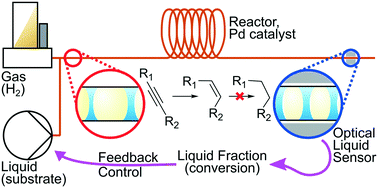当前位置:
X-MOL 学术
›
React. Chem. Eng.
›
论文详情
Our official English website, www.x-mol.net, welcomes your feedback! (Note: you will need to create a separate account there.)
Counting bubbles: precision process control of gas–liquid reactions in flow with an optical inline sensor†
Reaction Chemistry & Engineering ( IF 3.9 ) Pub Date : 2018-10-23 00:00:00 , DOI: 10.1039/c8re00186c Nikolay Cherkasov 1, 2, 3, 4, 5 , Antonio José Expósito 1, 2, 3, 4, 5 , Yang Bai 1, 2, 3, 4 , Evgeny V. Rebrov 1, 2, 3, 4, 5
Reaction Chemistry & Engineering ( IF 3.9 ) Pub Date : 2018-10-23 00:00:00 , DOI: 10.1039/c8re00186c Nikolay Cherkasov 1, 2, 3, 4, 5 , Antonio José Expósito 1, 2, 3, 4, 5 , Yang Bai 1, 2, 3, 4 , Evgeny V. Rebrov 1, 2, 3, 4, 5
Affiliation

|
Quality by Design encouraged by the US Food and Drug Administration (FDA) in continuous flow synthesis requires tight monitoring of all the reaction input and output parameters to improve reproducibility and eliminate the process rejects. Reaction monitoring, however, relies on costly (over 10 000$) process analytical technology (PAT) – one of the factors that prevents the wider utilisation of continuous processes. In this work, we show that gas–liquid reactions can be monitored using low-cost (10$) hardware – an optical liquid inline sensor – that allows instantaneous analysis of the gas fraction in a moving stream. We discuss the application of the sensor for various gas–liquid reactions. Gas-consuming reactions such as hydrogenation are the easiest to implement because a sensor without calibration provides accurate readings close to complete consumption of the gas. Gas-evolving reactions can be monitored but require sensor calibration to determine the gas fraction accurately. Operation of the sensor was demonstrated for various hydrogenation reactions self-optimised using a proportional–integral (PID) algorithm which adjusted the substrate concentration to provide high (but not full) pre-defined hydrogen consumption. The optimised hydrogen consumption agreed with the product analysis for a range of substrates hydrogenated under various pressures and with different selectivities. The optical sensor was also proven to be an efficient tool in adapting the reaction conditions to catalyst deactivation in the reaction of 2-methyl-3-butyn-2-ol semi-hydrogenation – the autonomous reactor allowed a turn-over number (TON) of 2.7 × 106 to be reached with a value of 1.5 × 107 expected till a twofold decrease in the catalyst activity. The TON values demonstrated are significantly higher than those observed in batch reactors (∼103) even in the case of catalyst re-use (105) demonstrating a substantial improvement of process sustainability operating with the process control.
中文翻译:

气泡计数:使用光学在线传感器对气流中的气液反应进行精确的过程控制†
由美国食品和药物管理局(FDA)鼓励进行连续流合成的“设计质量”要求严格监控所有反应输入和输出参数,以提高重现性并消除工艺废品。但是,反应监测依赖于昂贵的(超过1万美元)过程分析技术(PAT),这是阻止广泛使用连续过程的因素之一。在这项工作中,我们证明了可以使用低成本(10 $)硬件–光学液体在线传感器–监视气液反应,该硬件可以即时分析移动流中的气体含量。我们讨论了传感器在各种气液反应中的应用。诸如氢化之类的耗气反应是最容易实现的,因为未经校准的传感器可提供接近于完全耗气的准确读数。可以监测气体发生的反应,但需要进行传感器校准才能准确确定气体分数。使用比例积分(PID)算法对传感器进行了自我优化的各种加氢反应得到了证明,该算法调整了底物浓度以提供高(但不完全)的预先定义的氢消耗量。优化的氢气消耗量与在各种压力和不同选择性下氢化的一系列底物的产物分析相符。6至1.5×10的值达到7预期直到在催化剂活性的双重降低。即使在催化剂再利用(10 5)的情况下,所证明的TON值也显着高于在间歇反应器中观察到的TON值(〜10 3),这表明在过程控制下操作过程的可持续性有了实质性的改善。
更新日期:2018-10-23
中文翻译:

气泡计数:使用光学在线传感器对气流中的气液反应进行精确的过程控制†
由美国食品和药物管理局(FDA)鼓励进行连续流合成的“设计质量”要求严格监控所有反应输入和输出参数,以提高重现性并消除工艺废品。但是,反应监测依赖于昂贵的(超过1万美元)过程分析技术(PAT),这是阻止广泛使用连续过程的因素之一。在这项工作中,我们证明了可以使用低成本(10 $)硬件–光学液体在线传感器–监视气液反应,该硬件可以即时分析移动流中的气体含量。我们讨论了传感器在各种气液反应中的应用。诸如氢化之类的耗气反应是最容易实现的,因为未经校准的传感器可提供接近于完全耗气的准确读数。可以监测气体发生的反应,但需要进行传感器校准才能准确确定气体分数。使用比例积分(PID)算法对传感器进行了自我优化的各种加氢反应得到了证明,该算法调整了底物浓度以提供高(但不完全)的预先定义的氢消耗量。优化的氢气消耗量与在各种压力和不同选择性下氢化的一系列底物的产物分析相符。6至1.5×10的值达到7预期直到在催化剂活性的双重降低。即使在催化剂再利用(10 5)的情况下,所证明的TON值也显着高于在间歇反应器中观察到的TON值(〜10 3),这表明在过程控制下操作过程的可持续性有了实质性的改善。



























 京公网安备 11010802027423号
京公网安备 11010802027423号